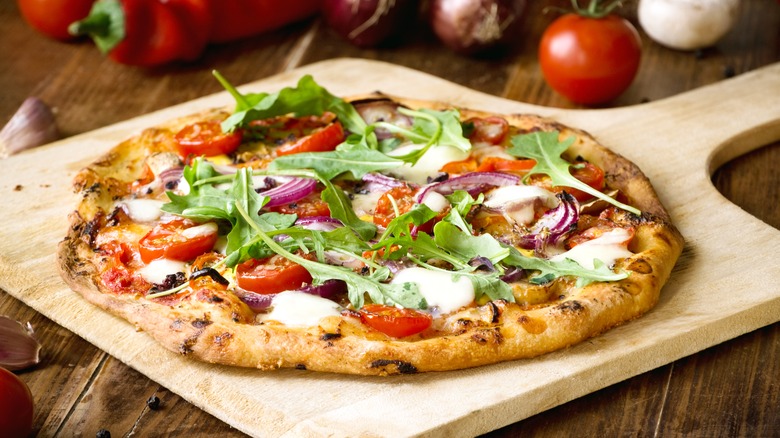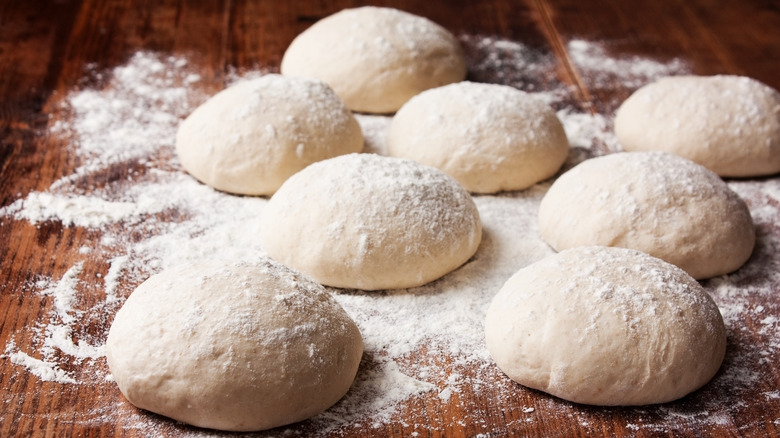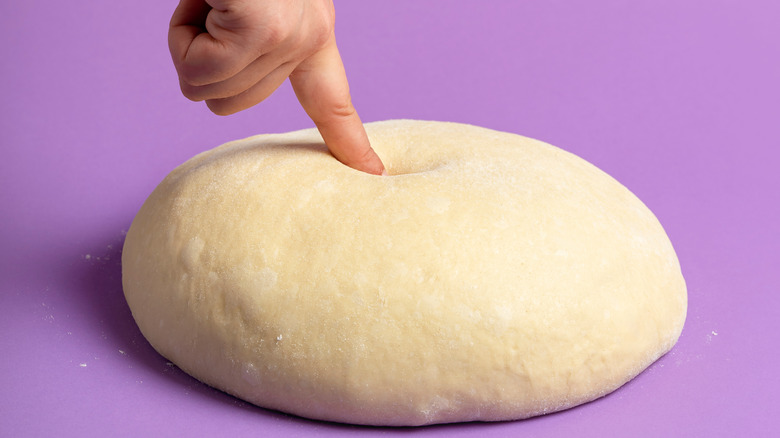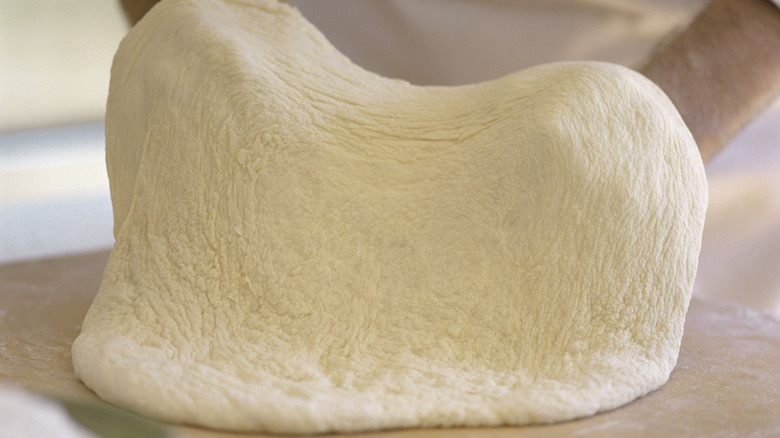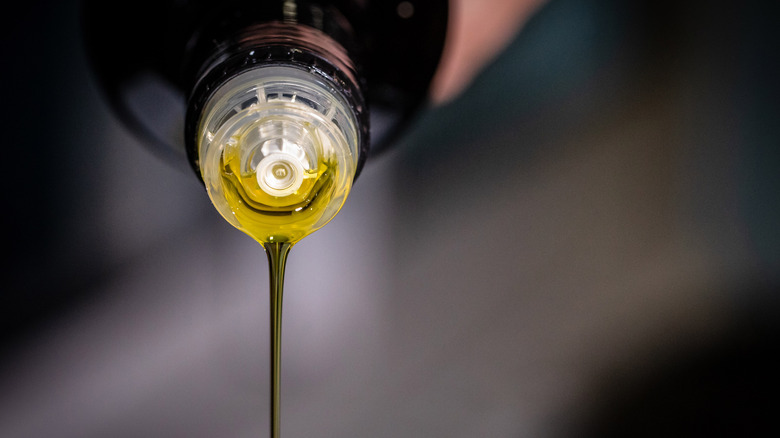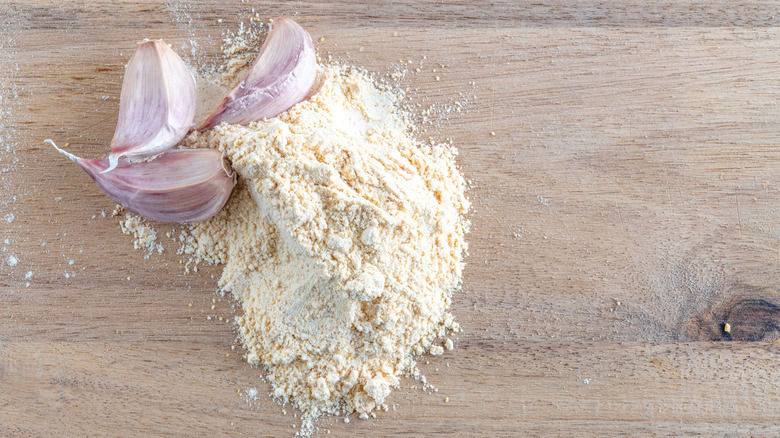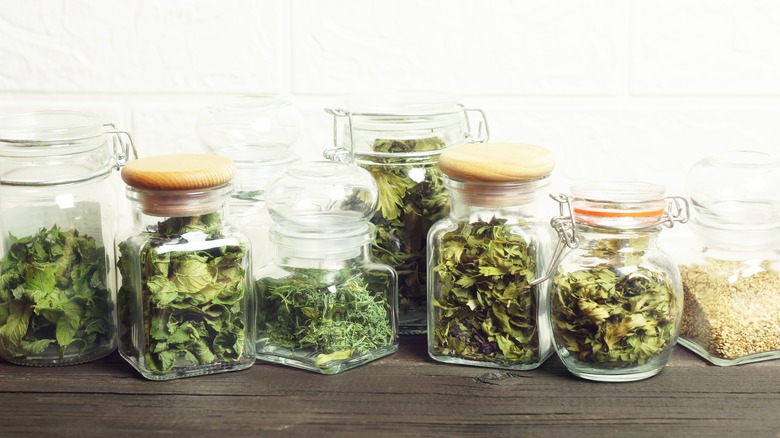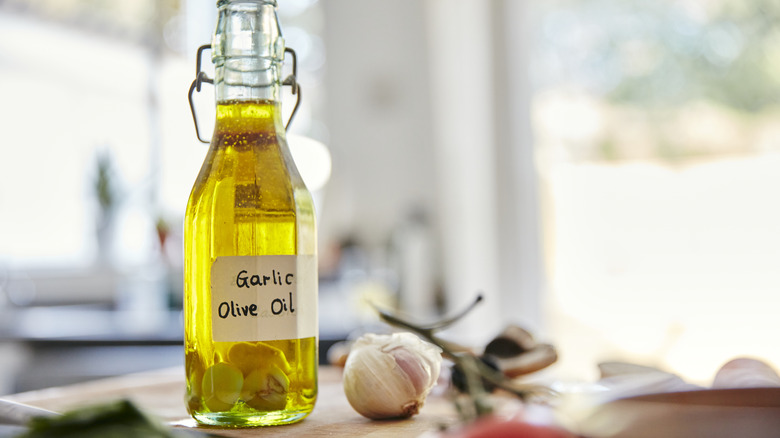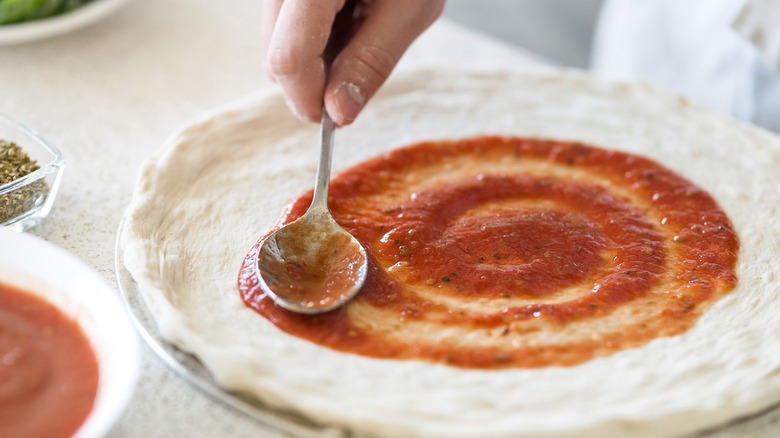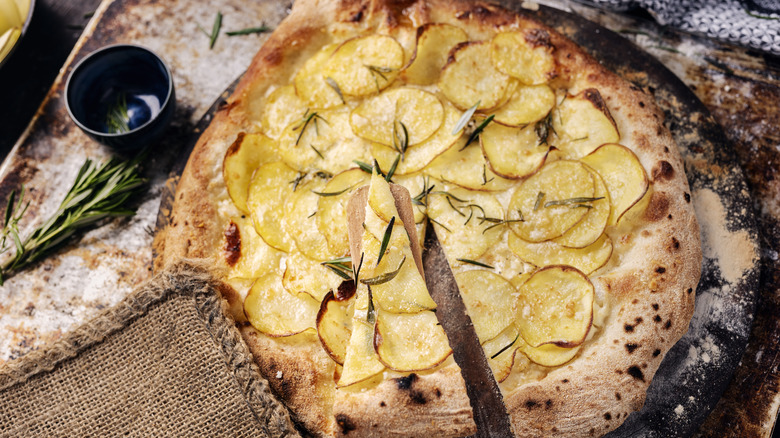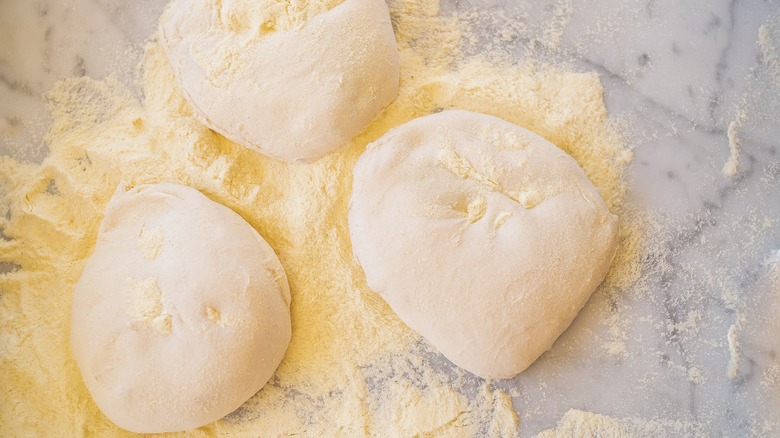12 Simple Ways To Make Store-Bought Pizza Dough Taste Homemade
It's easy enough to make your own pizza dough from scratch, whether you're looking for a thin-crust pizza recipe or something with more lift. However, you may not always have the time in your day for that, meaning you need to reach for something pre-made. We know that not everyone has the time or inclination to make their own pizza dough. Maybe you're fine with homemade dough as a weekend project but not on weeknights or perhaps you're just not that into the idea of making it from scratch. Either way, you might end up relying on store-bought pizza dough. It's good in a pinch, but it can absolutely be better with the right techniques and ingredients.
So, how can you make store-bought pizza dough taste homemade? The reality is that it's probably not going to be quite the same, but you can get some good results with a few handy tricks. We're here to share some simple ways to make grocery store pizza dough taste as if you made it from scratch.
But before you get started, the type of dough you buy matters. The pre-rolled type generally won't give you good results whatever you do with it. Instead, the varieties that come in large bags stored in cold cases (oftentimes in or near the store's deli section) are definitely the way to go. We ranked some popular store-bought pizza doughs to help you out. Once you've selected those, here's how to amp up its flavor, texture, and appearance.
1. Ball up the dough
Store-bought pizza dough generally comes in a large unshaped lump. Many people just use it straight out of the bag, but you can greatly improve your dough and make it more like homemade simply by balling it up. It might sound strange that this makes any difference at all, but stick with us.
Gasses inside the dough are released as it does its final rise. Balling the dough tightly helps you achieve those coveted crust bubbles, plus creates an airier texture inside. Balling this dough before leaving it for a final rise also gives the dough a chance to relax, making it far easier to shape. If you've been plagued by store-bought dough that tears all too easily, this will make a serious difference. And let's not forget that these packages of store-bought dough usually contain more than you need for a single pizza, so it makes even more sense to split and ball it.
First, split your refrigerated package of dough into pieces of around 1/2 pound each (this is enough to make a 10- to 12-inch pizza). Most bags of store-bought dough contain one pound, so this portioning step is easy enough to eyeball. Then, form a ball out of each piece by rolling it on the counter or folding the edges of the dough towards the center. Ensure the surface of the dough is taut, as this helps with crust structure.
2. Give your pizza dough enough time to rise
It's not just about shaping your pizza dough into balls, but also about giving it time to do its thing. The pizza dough you buy from the store has already been left to rise once, though at low temperatures to slow down fermentation and keep it from becoming over-proofed. However, it still needs a second proofing before it goes into the oven.
After you've balled your pizza dough, cover it and leave at room temperature for three to four hours. The dough will still be cold from the fridge and will need a longer second proof than room-temperature dough would. However, if you're short on time, leaving the balls to proof for another one to two hours is better than nothing. Once it's risen, if you gently poke the surface, the indentation will stay rather than instantly spring back.
If you let your crust properly rise for a second time, it will be both easier to shape and have those impressive bubbles you expect from good homemade dough. The extra proofing time should also increase the complexity of the flavor of the dough.
3. Learn how to stretch pizza dough
If you want your pizza to look right and have the correct texture, you need to learn to stretch your dough. There's a reason why you should never use a rolling pin on pizza dough, because it knocks out all those air bubbles you've worked so hard to create. This leaves the finished pizza flat and lacking in texture. Meanwhile, one that's been carefully stretched will have a better structure with bubbles of varying sizes.
After proofing your dough for the second time, lightly flour your work surface and place a dough ball on it. Using your fingertips, press the dough outward from the center, creating a flat disc while leaving a slightly thicker rim around the edge for the crust. At this stage, you're just creating a rough circle that will be much thicker and smaller than what you're aiming for.
After this initial flattening, lift the dough and begin to stretch it using the backs of your hands. Hold the dough up, letting gravity help stretch it as you gently move your hands around the edges, allowing the dough to drape over them. Rotate the dough so it stretches evenly. Try to be gentle, as it's easy to tear the dough or create thin spots. When you think you're done, lay the dough on your counter to check its shape and thickness. Make adjustments by gently pulling the edges or pressing thicker areas.
4. Drizzle your dough with olive oil
Want a flavorful pizza that tastes like was made at home? Olive oil can come to the rescue. Store-bought dough sometimes contains cheaper oils. But, even if it uses olive oil, it's likely to be a fairly low quality one. Up the ante by using a high-quality olive oil and reaping the tasty rewards that come.
There are a few points at which you can use olive oil in your dough improving journey. For starters, when you ball the dough in preparation for its second rise, lightly coat it with the oil. Not only does this keep the dough from drying out as it proofs, it also lends great flavor, especially if you use a less refined extra virgin olive oil. The next opportunity to add some oil is to brush it on the crust before adding toppings. This can help give the crust a crisp texture while adding yet more flavor. Again, a decent extra virgin olive oil scores you extra points here.
Finally, drizzle some on your pizza right after baking. This is where you can bring out the big guns. If you have some fancy extra-virgin olive oil you only use for finishing dishes, it will shine on your pizza at this opportunity.
5. Add garlic and onion powder to the dough
While adding extra flavor to the pizza dough is a giant no-no for some traditionalists, other people love it. If you're someone who would always prefer to add a little something extra to your homemade dough, you can absolutely do just that with the store-bought stuff, too. So, consider adding some garlic and onion powder to the mix. Both bring a punch of flavor and make the dough more like what you produce if you making it from scratch.
The trouble is that integrating these seasonings into dough that's already been made can be tricky. Some people assume you just can't do it. However, it can be done. You just need to know when and how to best work them in.
The time to strike is when you take your bag of dough and divide it into individual balls. While you don't want to work the dough too much at this stage, it can take some handling. Gradually sprinkle the onion and garlic powder over the dough, folding it in, before stretching the dough out again and folding in some more. After this, form balls and leave them to rise for a few hours. This additional proofing time will help the strands of gluten protein in the dough relax so that you can stretch and shape it later.
6. Add herbs to the dough
Onion and garlic powder aren't the only options if you want to infuse your dough with more flavor, so try adding some herbs. You can use practically any herb in pizza dough, though the more complex truth is that some work better than others. Experimenting with varieties and combinations can give you interesting results.
Basil, oregano, rosemary, and thyme are all strong choices. These are commonly used in Italian cuisine, so they tend to blend well with classic pizza toppings. Other options include parsley, sage, or marjoram. And even though it's technically not an herb, consider using ground fennel seeds.
When it comes to using fresh or dried herbs in pizza dough, both have their merits. Fresh herbs generally provide a brighter, more vibrant flavor and can add subtle aromatic notes to the dough. Some fresh herbs are vastly superior to their dried counterparts, including basil and parsley. However, fresh herbs can be tricky to work into the dough. Dried herbs are better for that purpose and potentially more convenient — in fact, you probably have a whole section of your pantry dedicated to them.
7. Use seasoned oil on the crust
Boost the flavor of your store-bought crust by using seasoned oil on the crust. You might not be able to do much about how well-developed or nuanced the taste of the crust is without making it yourself from scratch. However, if you're finding grocery store crusts somewhat lacking in the flavor department, this is a good way to go. No, it won't make it more complexly bready, but it will add enough of a boost that you don't notice or don't care.
But, what do we mean by seasoned oil? Well, it's a fairly loose description, but basically any oil with additional aromatics fits the bill. Use a store-bought flavored oil, such as garlic, chili, herb, or lemon oil. The best versions of this will have the aromatics still in the bottle, slowly infusing. You could also use the oil left behind in a jar of artichokes or sun dried tomatoes.
Then, there's the option to make your own seasoned oil. Simply heat up half a cup of quality olive oil on a low flame and throw in some chopped garlic and herbs. Let it cook on the lowest burner setting for 5 to 10 minutes, then cool and strain. Brush some on your pizza crust and use the leftovers for cooking, dressing salads, or whatever else you like.
8. Try a base of garlic and olive oil
A surefire way to make a basic premade dough taste homemade is to go beyond the usual store-bought options. You'd probably expect a store-bought pizza to have red sauce, for instance. This means that, if you opt for a white pizza instead, it's likely going to seem more bespoke. So, in place of that standard pizza sauce, make a base of garlic and olive oil.
It's extremely simple to pull off. You just need to finely mince garlic or crush it into a paste with a garlic press or mortar and pestle. Then, mix it with olive oil and salt. This is a garlic and oil dressing at its most basic, though. If you feel up to some extra work, you can also add shallots and fresh herbs for more flavor. Simply spread this garlicky oil over your pizza base and top with whatever else you desire and you have a tasty white pizza on your hands.
That said, there are plenty of other ways to make white pizza. For instance, use a bechamel sauce or simply ttys pizza with piles of cheese. Take a look at our New York-style white pizza recipe to consider just one of your many options.
9. Make your own pizza sauce
You're taking a shortcut by using a store-bought pizza dough. But, if you want it to taste homemade once it's out of the oven, making your own pizza sauce is essential. A store-bought sauce just doesn't compare to a homemade one. In fact, using a homemade sauce is the secret to restaurant-quality pizza. Since you're saving time by not making your own dough, you can take a few minutes to make sauce from scratch.
To make a basic pizza sauce, start with high-quality canned whole tomatoes. Crush the tomatoes by hand or briefly pulse them in a food processor. Mix in minced garlic, salt, pepper, and oregano. If it's too thin, add a little tomato paste to thicken things up. The beauty of this method is that the resulting sauce doesn't even need to be cooked. Instead, it simply cooks in the oven while it's on the pizza.
This process only takes a few minutes and results in a flavorful sauce that's way better than many store-bought options. So, you have little excuse not to make your own pizza sauce. Once you've tried it, you'll wonder why you ever bought it ready-made from the store.
10. Focus on the toppings
So, your grocery store dough might not quite reach the heights of a homemade one. However, if you shift your focus to toppings, you'll soon forget about that. Great toppings can cover a multitude of sins, so it's absolutely worth paying attention to them.
Your focus should be on fresh, high-quality toppings. We've already mentioned making your own sauce or even going so far as to use a white sauce base. You could also use homemade pesto as the sauce layer of your pizza or whip up a butternut squash cream. Then, move onto the other toppings. Your choice of cheese is important, whether you want to stick to a quality mozzarella or branch out into other cheese choices, such as blue cheese or goat cheese. With dairy-free cheese alternatives, a high-end brand or a homemade cashew cheese will likely beat most supermarket options.
As for proteins and veggies, you have many choices. Consider mushrooms sautéed with garlic, roasted bell peppers and zucchini, thinly-sliced potatoes, and pepperoni. These are just a small handful of suggestions out of a practically limitless array of toppings. Opt for left-field toppings when you're feeling brave, such as mac and cheese or a nacho-inspired combination complete with corn chips. The order you top it in matters, too. Generally, you should go sauce, cheese, and then other toppings.
11. Use a pizza stone or a baking steel
Level-up your store-bought dough by using a pizza stone or a baking steel (sometimes called a pizza steel). But before you do, learn the differences and similarities between pizza stones and pizza steels. A pizza stone is made of ceramic, cordierite, or a composite material. It's designed to be preheated in the oven before you place your pizza on it to bake. Pizza stones help create a crispy crust by absorbing moisture from the dough and maintaining a consistently high temperature.
A baking steel is similar in concept but made of steel. It's a flat, heavy plate of steel that serves the same purpose as a pizza stone. Baking steels have gained popularity among home pizza makers in recent years. They're more conductive than pizza stones so they can improve the crust even more. Plus, they aren't at risk of cracking from thermal shock. However, they're usually more expensive.
Both pizza stones and baking steels provide a scorching hot surface for baking, helping make the underside of the pizza crispier. They also distribute heat evenly, so your pizza cooks more uniformly. On a small scale, they're able to simulate the effect of a brick oven by storing and radiating intense heat. Whichever you choose, it's a great way to improve the quality of your grocery store crust.
12. Sprinkle semolina on the baking surface or pizza peel
Using ground semolina on your baking surface or pizza peel is a simple upgrade but one that will give your pizza the crunchy finish that so many people love. Plus, it can help transfer your pizza to the oven more easily.
When you bake pizza on a stone or steel, you must preheat it. This means you can't build your pizza on the surface. Instead, you need to assemble it on a peel and then transfer it onto the baking surface. The same goes if you use a pizza oven. The trouble is, pizza dough is notoriously sticky and can get caught on the peel. The coarse texture of semolina allows the pizza to slide easily onto the baking surface. This is crucial for transferring the pizza smoothly into the oven without disturbing the shape or toppings. Even if you don't use a peel, you can sprinkle semolina on your pan or other baking surface for authentic flavor and texture.
As the pizza cooks, the semolina browns, giving the crust a pleasant toasty flavor and a satisfying crunch. This texture contrast is often found in high-quality pizzerias and can make your home-baked pizza feel more authentic and artisanal.
